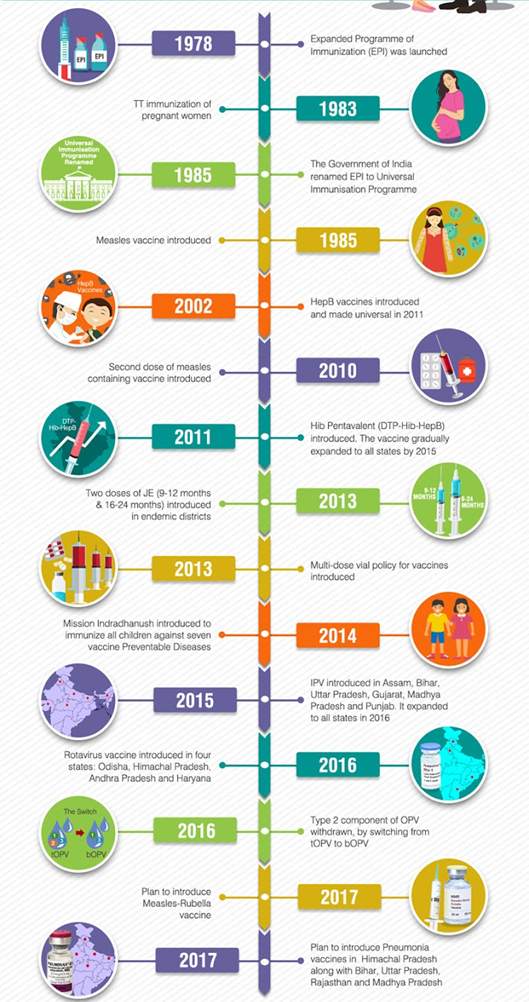- Courses
- GS Full Course 1 Year
- GS Full Course 2 Year
- GS Full Course 3 Year
- GS Full Course Till Selection
- Answer Alpha: Mains 2025 Mentorship
- MEP (Mains Enrichment Programme) Data, Facts
- Essay Target – 150+ Marks
- Online Program
- GS Recorded Course
- Polity
- Geography
- Economy
- Ancient, Medieval and Art & Culture AMAC
- Modern India, Post Independence & World History
- Environment
- Governance
- Science & Technology
- International Relations and Internal Security
- Disaster Management
- Ethics
- NCERT Current Affairs
- Indian Society and Social Issue
- NCERT- Science and Technology
- NCERT - Geography
- NCERT - Ancient History
- NCERT- World History
- NCERT Modern History
- CSAT
- 5 LAYERED ARJUNA Mentorship
- Public Administration Optional
- ABOUT US
- OUR TOPPERS
- TEST SERIES
- FREE STUDY MATERIAL
- VIDEOS
- CONTACT US
50 Years of the Expanded Programme on Immunization
50 Years of the Expanded Programme on Immunization
03-05-2024
The year 2024 marks 50 years since the World Health Organization (WHO) launched the Expanded Program on Immunization (EPI) in 1974, now known as the Essential Program on Immunization. This program has evolved to provide protection against many vaccine-preventable diseases and has made significant contributions to global health.
About Essential Programme on Immunization:
- Established in 1974 by WHO, the program initially focused on protecting children from 6 childhood vaccine-preventable diseases:
- Bacillus Calmette-Guérin (BCG)
- diphtheria
- pertussis
- tetanus
- polio
- measles
- Over time, WHO expanded the program to include 7 more diseases:
- Haemophilus influenzae type B (Hib)
- Hepatitis B (HepB)
- rubella
- pneumococcal disease (PNC)
- rotavirus (Rota)
- human papillomavirus (HPV)
- COVID-19 (for adults)
India's Universal Immunization Programme (UIP):
100 Percent Funded by the central government. UIP is one of the key interventions for protection of children from life threatening conditions by providing vaccination.
- Launched in 1978 as the EPI, India renamed the program as the Universal Immunization Programme (UIP) in 1985.
- The UIP aims to rapidly increase immunization coverage, improve service quality, establish a reliable cold chain system to health facilities, monitor performance, and achieve self-sufficiency in vaccine production.
- All pregnant women and children can get vaccinated at government or private health facilities or designated immunization session sites.

- The UIP provides high-quality vaccines to all sections of society across the country.
- Under UIP, free vaccination is provided against 12 vaccine-preventable diseases.
- 9 diseases are covered nationally: Diphtheria, Pertussis, Tetanus, Polio, Measles, Rubella, severe Childhood Tuberculosis, Hepatitis B, and Meningitis & Pneumonia caused by Hemophilus Influenza type B.
- 3 diseases are covered sub-nationally: Rotavirus diarrhea, Pneumococcal Pneumonia, and Japanese Encephalitis. Rotavirus vaccine and Pneumococcal Conjugate vaccine are in expansion, while JE vaccine is only provided in endemic districts.
What is Immunization?
Immunization (also commonly called vaccination) is a process that helps your body develop protection against a specific disease.
- Protection: Immunization gives you immunity to a disease without having to get sick with the disease first. Immunity means you are protected from becoming ill if exposed to the disease-causing germs.
- Vaccines: Immunization works by introducing a vaccine into your body. Vaccines are created in a way that mimics the disease-causing germ (virus or bacteria), but in a killed, weakened, or partial form that won't actually make you sick.
How does immunization work?
- Exposure: When you get a vaccine, your body is exposed to the safe, modified version of the germ.
- Immune Response: Your immune system, designed to fight disease, is triggered. It recognizes the germ as foreign and starts making antibodies.
- Memory: Your immune system remembers how to fight the specific germ. If you're ever exposed to the actual disease, your body has the antibodies ready to fight it off before you get sick.
Why is immunization important?
- Individual Protection: Immunization helps you avoid getting seriously ill or having complications from preventable diseases.
- Community Protection (Herd Immunity): When enough people in a community are immunized, it helps prevent diseases from spreading easily. This protects those who cannot get vaccinated, like infants or people with weakened immune systems.
Types of Vaccines
- Live-attenuated: Use a weakened form of the germ. (Examples: Measles, mumps, rubella (MMR) )
- Inactivated: Use a killed version of the germ. (Examples: Polio, hepatitis A)
- Subunit, recombinant, polysaccharide, and conjugate: Use specific pieces of the germ, such as its protein, sugar, or casing. (Examples: Whooping cough, Hib disease)
- Toxoid: Use a toxin created by the germ to build immunity. (Example: Tetanus, diphtheria)
- mRNA: Provide instructions to your cells to create parts of the virus, triggering the immune response (Example: some COVID-19 vaccines)
Must Check: Best IAS Coaching In Delhi



